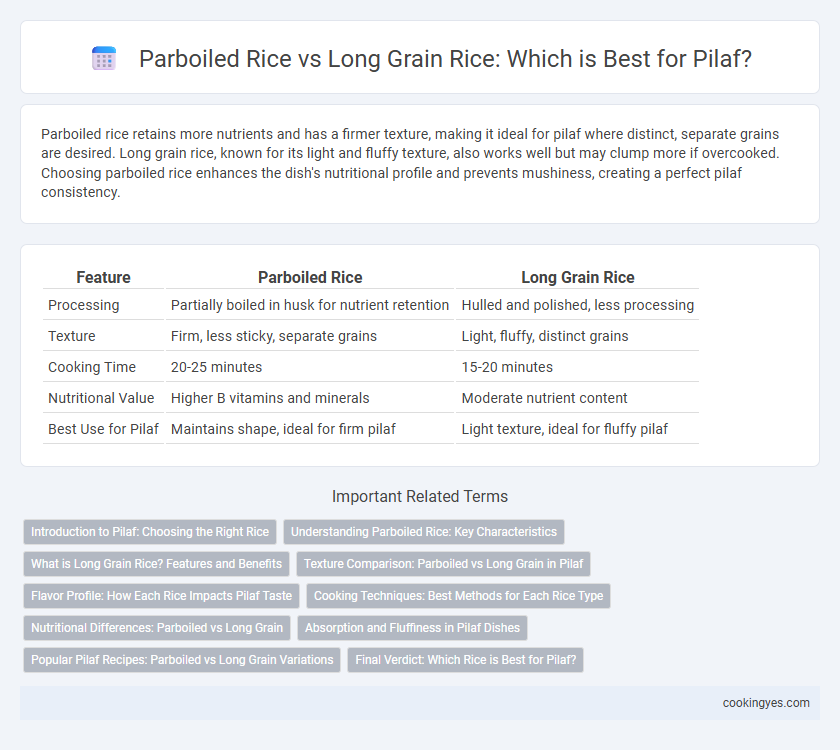Parboiled rice retains more nutrients and has a firmer texture, making it ideal for pilaf where distinct, separate grains are desired. Long grain rice, known for its light and fluffy texture, also works well but may clump more if overcooked. Choosing parboiled rice enhances the dish's nutritional profile and prevents mushiness, creating a perfect pilaf consistency.
Table of Comparison
| Feature | Parboiled Rice | Long Grain Rice |
|---|---|---|
| Processing | Partially boiled in husk for nutrient retention | Hulled and polished, less processing |
| Texture | Firm, less sticky, separate grains | Light, fluffy, distinct grains |
| Cooking Time | 20-25 minutes | 15-20 minutes |
| Nutritional Value | Higher B vitamins and minerals | Moderate nutrient content |
| Best Use for Pilaf | Maintains shape, ideal for firm pilaf | Light texture, ideal for fluffy pilaf |
Introduction to Pilaf: Choosing the Right Rice
Pilaf requires rice varieties that maintain distinct grains and absorb flavors effectively, making long grain and parboiled rice prime candidates. Long grain rice offers a light, fluffy texture due to its lower amylopectin content, preventing clumping in pilaf dishes. Parboiled rice features a firmer texture and enhanced nutritional profile from its steaming process, which also improves the rice's ability to absorb spices and liquids without becoming mushy.
Understanding Parboiled Rice: Key Characteristics
Parboiled rice is partially boiled in the husk, which enhances its nutritional value by driving vitamins and minerals from the bran into the grain. Its firmer texture and resistance to stickiness make it ideal for pilaf dishes that require separate, fluffy grains. The translucent appearance and nutty flavor distinguish parboiled rice from long grain varieties, offering a distinct culinary experience.
What is Long Grain Rice? Features and Benefits
Long grain rice has a slender shape and remains separate and fluffy when cooked, making it ideal for pilaf dishes. Its firm texture absorbs flavors well without becoming sticky, contributing to a light, airy dish. The high amylose content in long grain rice enhances its ability to stay fluffy, providing a superior texture for flavorful, visually appealing pilafs.
Texture Comparison: Parboiled vs Long Grain in Pilaf
Parboiled rice features a firmer, less sticky texture ideal for pilaf, maintaining individual grains and resisting clumping during cooking. Long grain rice offers a light and fluffy texture with distinct, separate grains that absorb flavors evenly, enhancing the pilaf's aromatic profile. Texture preference in pilaf depends on whether a chewier consistency or a tender, airy rice base is desired.
Flavor Profile: How Each Rice Impacts Pilaf Taste
Parboiled rice offers a nutty, slightly earthy flavor with a firmer texture that holds well in pilaf, enhancing the dish's overall heartiness and preventing mushiness. Long grain rice delivers a delicate, mildly floral taste with a fluffy and separate grain structure, creating a lighter, airier pilaf experience. Choosing between parboiled and long grain rice directly influences the pilaf's flavor depth and texture, catering to either robust or subtle palate preferences.
Cooking Techniques: Best Methods for Each Rice Type
Parboiled rice maintains firmness and separates well after boiling due to its steaming process, making it ideal for pilaf techniques that involve sauteing grains before simmering. Long grain rice requires gentle simmering with precise water absorption and minimal stirring to keep the grains fluffy and distinct, key for achieving the perfect pilaf texture. Selecting the right cooking method enhances the unique qualities of each rice type, ensuring a flavorful and visually appealing pilaf.
Nutritional Differences: Parboiled vs Long Grain
Parboiled rice retains more nutrients such as thiamine and niacin due to its steaming process, which drives vitamins from the bran into the kernel, making it more nutritious than long grain rice. Long grain rice, while lower in fiber and certain vitamins, typically has a lower glycemic index than parboiled rice, which can influence blood sugar management. Both types offer essential carbohydrates and proteins, but parboiled rice provides enhanced mineral content like iron and calcium, benefiting overall health in pilaf dishes.
Absorption and Fluffiness in Pilaf Dishes
Parboiled rice offers superior absorption properties, allowing it to soak up more broth or stock in pilaf dishes without becoming mushy, resulting in distinct, separate grains. Long grain rice is prized for its natural fluffiness and elongation during cooking, creating a light texture that enhances the pilaf's visual appeal and mouthfeel. Both types contribute uniquely to pilaf, with parboiled rice maintaining firmness and long grain rice delivering a delicate, airy bite.
Popular Pilaf Recipes: Parboiled vs Long Grain Variations
Parboiled rice is favored in popular pilaf recipes for its firm texture and ability to retain shape, preventing the dish from becoming mushy, while long grain rice is prized for its fluffy, separate grains that absorb flavors well. Variations like Middle Eastern pilaf often use long grain rice to achieve a delicate, light consistency, whereas South Asian versions tend to incorporate parboiled rice to enhance nutritional value and maintain grain integrity during slow cooking. Choosing between parboiled and long grain rice significantly influences the texture and flavor profile of pilaf dishes, catering to regional preferences and cooking techniques.
Final Verdict: Which Rice is Best for Pilaf?
Parboiled rice offers a firmer texture and less stickiness, making it ideal for pilaf that requires separate, distinct grains. Long grain rice, especially basmati, provides a light, fluffy consistency and aromatic flavor that enhances pilaf dishes. Choosing between parboiled and long grain rice depends on whether a firmer bite or fragrant, delicate flakes are preferred in the final pilaf.
Parboiled vs Long Grain for Pilaf Infographic

 cookingyes.com
cookingyes.com